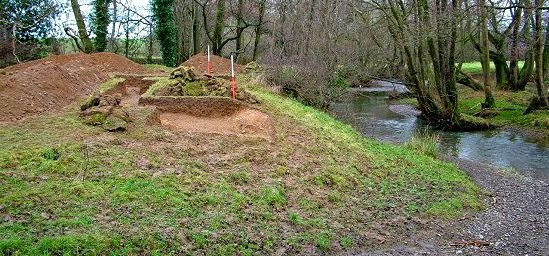Brigit's Well Carrog.Image Copyright Chris Jones
Water is life . For example the city of Bath exists due to the merging of three natural springs in the heart of the city which now deliver over one million litres of water a day. The importance of the site scans 10,000 years from the Mesolithic period to the present day .
What makes a spring or watery place special? Why are some places associated with a goddess or spirit and others ignored? Some areas are devoid of sacred well and water worship whilst others seem to have been a focus for ritual activity from at least the Neolithic period around six thousand years ago.
An example of an early site for ritual activity around a natural spring has been discovered in Wales .
Hindwell discussed here at the Clwyd Powis Archaeological Trust website http://www.cpat.org.uk/projects/longer/walton/walton12-14.htm
It is thought that the original activity at this site may have focused on a natural spring
The site grew to eventually cover over 85 acres - thirty times the size of Stonehenge . The implications are that the site had a ritual function though the exact meaning of this over it's life time has eluded archaeological investigation.
It's hard to say with any certainty if Holywells and Healing Wells such as Ffynnon Sara near Derwen in Denbighshire have early origins in prehistory as there is no firm on the ground archaeological evidence to support this theory .
Wales has more than it's fair share of sacred watery places which are still a magnet for pilgrimage, worship, offerings and connection to deities, ancestors and the distant past . This is an area I will explore and develop further .
Some examples of springs and wells I have looked at are shown below. Not all have a rich collection of folklore attached to them and need further research to answer the question 'why' people travel great distances to venerate the site and to seek cures at them , such a place is Brockweir in the Wye Valley.
Local residents seemed to know nothing about the folklore or origins of the worship at or pilgrimage of the site although they did state that many people from far away knew of the spring and travelled there to seek cures or leave offerings presumably to their own deities or spirit of the spring
So why do we and how do we venerate water ? Why do we want to have our feet in the Wishing Well and how far into the mists of time do rituals and traditions surrounding watery places extend back ?
There are many questions to be asked about how the thin veil between Christian and Pagan overlaps and why so many of us of all beliefs and religions still seek something at these very thin and liminal places where we still throw coins, leave personal objects , perform rituals and send up wishes to the saint or deity of our choice .
St Seiriols Well Penmon Anglesey








No comments:
Post a Comment